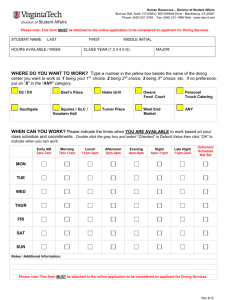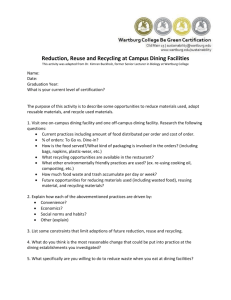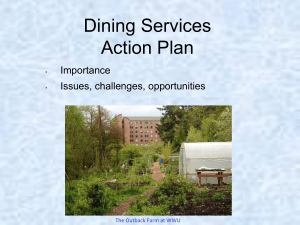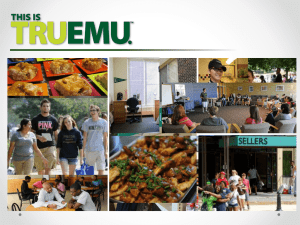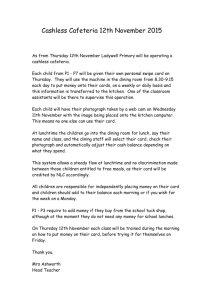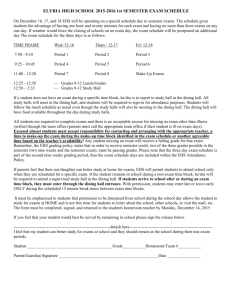Interview Data
advertisement
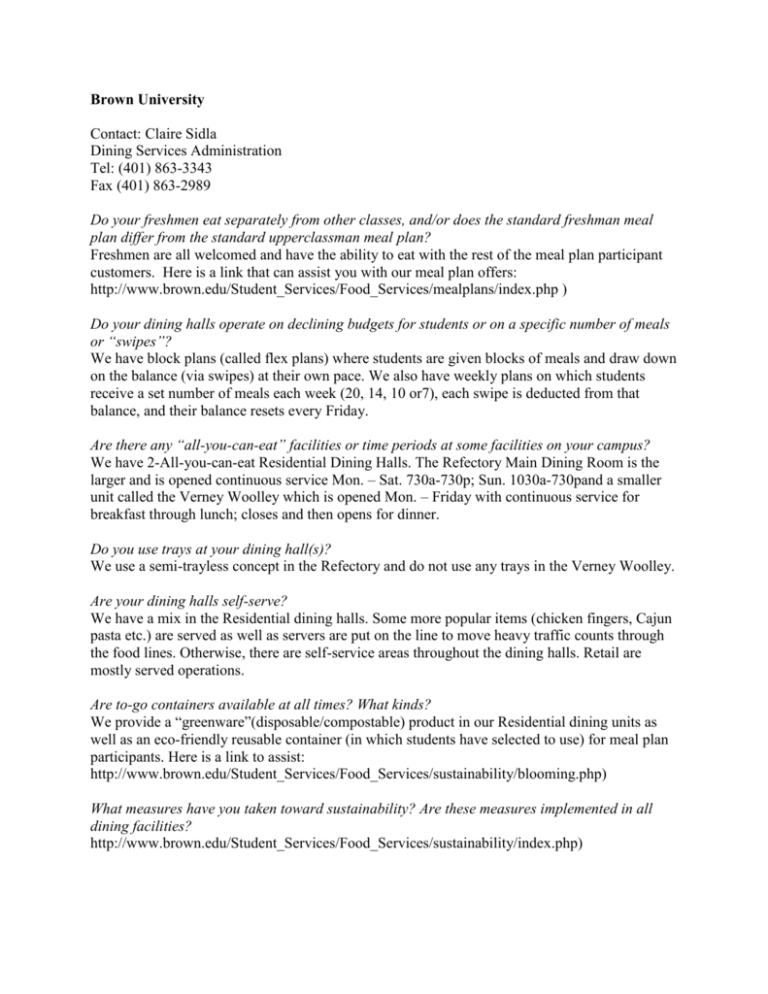
Brown University Contact: Claire Sidla Dining Services Administration Tel: (401) 863-3343 Fax (401) 863-2989 Do your freshmen eat separately from other classes, and/or does the standard freshman meal plan differ from the standard upperclassman meal plan? Freshmen are all welcomed and have the ability to eat with the rest of the meal plan participant customers. Here is a link that can assist you with our meal plan offers: http://www.brown.edu/Student_Services/Food_Services/mealplans/index.php ) Do your dining halls operate on declining budgets for students or on a specific number of meals or “swipes”? We have block plans (called flex plans) where students are given blocks of meals and draw down on the balance (via swipes) at their own pace. We also have weekly plans on which students receive a set number of meals each week (20, 14, 10 or7), each swipe is deducted from that balance, and their balance resets every Friday. Are there any “all-you-can-eat” facilities or time periods at some facilities on your campus? We have 2-All-you-can-eat Residential Dining Halls. The Refectory Main Dining Room is the larger and is opened continuous service Mon. – Sat. 730a-730p; Sun. 1030a-730pand a smaller unit called the Verney Woolley which is opened Mon. – Friday with continuous service for breakfast through lunch; closes and then opens for dinner. Do you use trays at your dining hall(s)? We use a semi-trayless concept in the Refectory and do not use any trays in the Verney Woolley. Are your dining halls self-serve? We have a mix in the Residential dining halls. Some more popular items (chicken fingers, Cajun pasta etc.) are served as well as servers are put on the line to move heavy traffic counts through the food lines. Otherwise, there are self-service areas throughout the dining halls. Retail are mostly served operations. Are to-go containers available at all times? What kinds? We provide a “greenware”(disposable/compostable) product in our Residential dining units as well as an eco-friendly reusable container (in which students have selected to use) for meal plan participants. Here is a link to assist: http://www.brown.edu/Student_Services/Food_Services/sustainability/blooming.php) What measures have you taken toward sustainability? Are these measures implemented in all dining facilities? http://www.brown.edu/Student_Services/Food_Services/sustainability/index.php) Dartmouth College Contact: Matthew C. Smith Dining Services & Campus Center Operations Tel: (603) 646-3726 Fax (603) 646-1735 How much food waste do your dining halls each generate each week/year? Has this stayed fairly constant over the years? I do not have figures handy, but you may find some on one of the links below. The food waste has deceased moderately, but the amount of compost and recycled items have increased substantially while our contribution to landfills has decreased greatly. We have just switched to an all-you-care–to-eat format for our main dining hall. This has greatly reduced packaging. We compost nearly everything that we cannot recycle. We do not have trash cans in our main dining hall. All rubbish is put on the trays, so our trained staff can separate and dispose of items properly. This alone has greatly reduced our contribution to landfills. Do your freshmen eat separately from other classes, and/or does the standard freshman meal plan differ from the standard upperclassman meal plan? Dartmouth is on a quarter system. First year students are required to have a specific meal plan for their first quarter, but they are free to change after fall term. The meal plans are valid at all locations, and freshman are free to choose which dining venue they eat at. Do your dining halls operate on declining budgets for students or on a specific number of meals or “swipes”? We operate on a hybrid system of declining balances and meal swipes. You can find details athttp://www.dartmouth.edu/dining/plans/ . Our main dining hall is an all you care to eat facility (swipe your ID at the door) while the others are a la carte (pay only for what you eat). Students can use their meal swipes at the a la carte facilities through use of a meal swipe equivalency, where a swipe is converted into a set amount of DBA. Are there any “all-you-can-eat” facilities or time periods at some facilities on your campus? Only the main dining hall is all-you-care-to-eat. (“All-you-can-eat” is a bit too much of a challenge a la Homer Simpson.) The 3 satellite locations are not. Do you use trays at your dining hall(s)? Yes. Are your dining halls self-serve? We’re mostly self-service. Our kosher kitchen is full service. Some of our a la carte facilities have self-service cold foods but the hot food is prepared to order and served by the staff. Are to-go containers available at all times? What kinds? Despite our protests, to-go food remains a huge part of Dartmouth. Our paper products are unbleached and compostable. The food is generally taken out in plastic “clamshell” containers. They are recyclable, and we do actively encourage customers to avoid to-go containers. Several student groups also actively campaign to encourage their peers to recycle. What measures have you taken toward sustainability? Are these measures implemented in all dining facilities? Sustainability is a key element of Dartmouth planning, and the efforts, both large and small, are too vast to quickly describe. As an independent college-operated dining service, the mission of the college is also our own. Our main dining hall has just been renovated and sustainability was a key part of the planning. Attached is a part of the opening program, which has some details. A lot of the other efforts are detailed online: http://www.dartmouth.edu/dining/ our main page does currently have some focus on sustainability including a documentary produced by several students who were nice enough to let us link to it. http://www.dartmouth.edu/dining/faq/sustainability.html This is a little dated, and we have increased the numbers since then http://www.dartmouth.edu/~sustain/dartmouth/dining.html http://www.dartmouth.edu/~sustain/ We’ve also hosted Barton Seaver, who taught our staff about sustainable seafood purchasing as well as food preparation. http://www.bartonseaver.org/ Sustainability is important to all locations, but the new facility is the only one with it designed in. As we renovate and update, our other facilities will be brought up to the high standards of our strategic sustainability planning. Stanford University Contact: Cynthia Liu Residential & Dining Enterprises Tel: (650) 725-9660 Fax: (650) 725-1507 Do your freshmen eat separately from other classes? No. We have some dining halls affiliated with all-frosh dormitories, but any student on the meal plan can dine at any one of eight of our dining halls. (We have three other dining halls that are row houses and not part of the open meal plan). Does the standard freshman meal plan differ from the standard upperclassman meal plan? There is no freshman meal plan separate from upperclassman meal plan. All undergrads can chose from one of three meal plans: 19 meals per week, 14 or 10 meals per week plus Meal Plan Dollars that can be used at Late Night or some of the retail cafes around campus. There is also an apartment meal plan for upperclassmen living in apartment-style residences that have their own kitchen: 5 meals per week plus Meal Plan Dollars. Freshmen are not put in apartment residences because there is less social interaction. Do your dining halls operate on declining budgets for students or on a specific number of meals or “swipes”? Not sure what you are asking here. Perhaps the answer above will suffice? Are all of your dining halls serviced by the same company? We are a department of the University, a self-op. We are not a contractor. Yes, we operate all of our dining halls. Do you have any outside vendors operating other places during mealtimes that students can eat at on the same plan? Yes, there are outside vendors operating some retail cafes on campus. They do not extend any meal plans to students and we have no affiliation with them. Our sister organization, Stanford Hospitality & Auxiliaries, operates some of the retail cafes on campus and our students can use Meal Plan Dollars there. We also partner with a few outside vendors such as Subway, which accepts Meal Plan Dollars. Are there any “all-you-can-eat” facilities or time periods at some facilities on your campus? All of our dining halls are all-you-care-to-eat. Our newest dining hall, Arrillaga Family Dining Commons, offers continuous service between meals, so there is food served there from 7:30 am to 8 pm. It’s a popular program that we just started this academic year, when we opened that dining hall. In addition, we have Late Night every night at Arrillaga Family Dining Commons from 9 pm to 2 am, as well as at Lakeside Sun through Thur from 9:30 pm to 2 am. Approximately how many people does a dining hall service per day? We serve 12,000 meals per day. There are around 4,000 undergrads on the meal plan (undergrads living in row houses and fraternities are not on our meal plan), plus we have many graduate students, staff and faculty dining in the dining halls. Do you use trays at your dining hall(s)? We went trayless a couple of years ago to be sustainable. However, we did not eliminate them completely because sometimes people with physical disabilities, athletes who eat a lot, people who happen to be schlepping a lot of stuff on a particular day or people who are eating a big bowl of hot Vietnamese pho soup need a tray. So the trays are not out and easily accessible, but if one asks the cashier, they can have a tray. Are your dining halls self-serve? Yes Are to-go containers available at all times? What kinds of to-go containers do you use? No. We are all-you-care-to-eat in your stomach. We do not allow people to take food out. Allyou-care-to-eat buffets don’t give to-go containers. As I said, the dining halls do not offer to-go containers. Our sister department’s retail cafes use compostable containers. What measures have you taken toward sustainability? Are these measures implemented in all dining facilities? Our Sustainable Food Program Manager educates the Stanford community on aspects of the sustainable food system; drives innovation in food systems through collaborative projects involving research, coursework and strategic partnerships; and implements projects that enhance margins as measured economically, socially and environmentally. Our Sustainable Food Program Manager works with our Procurement and Vendor Management department to create and enforce sustainable purchasing guidelines. Stanford Dining will continue with sustainability initiatives already implemented throughout the Stanford Dining program: · 40 percent local and organic food purchasing · 100 percent cage-free eggs · 100 percent Monterey Bay Aquarium Seafood Watch program “Good” or “Best” choice seafood · 15,000 pounds of wild Alaskan salmon purchased annually directly from Taku River Reds family fishery · Grass-fed beef hamburger patties from Marin Sun Farms · Organic non-fat milk from Clover Stornetta · ALBA Organics (Agriculture and Land-Based training Association) produce · Fryer waste oil to biodiesel · Spa water infused with fruit and herbs · Wash Your Mug program · Dining in the Daylight · Food waste composting at all dining halls · Trayless Dining · Support of SPOON (Stanford Project for Hunger) 2011-12 initiatives: · Niman Ranch pork · Organic whole apples (#1 on the USDA’s Dirty Dozen list) All meal plan students are given a free stainless steel water bottle to reduce plastic water bottle waste and reduce the carbon footprint caused by transporting bottled water onto campus. Duke Freeman Center Contact: Jeremy Yoskowitz Campus Rabbi Tel: (919) 684-6422 Rabbi Jeremy gave us free-form answers to the general questions: Do you have any idea what the reasons behind the lower amount of food waste in the Freeman Center as compared to The Marketplace might be? Has the Freeman Center done anything in particular to reduce their food waste? 1. Jewish Ethics. There is a Jewish principle called Baal Tashchit, which prohibits us from needless waste and/or destruction. While this is often held up as a guiding principle for a number of organizations, it is one that is very easily applied practically. This leads us to the second item: 2. Deliberation. We're very careful in what and how much we both order and prepare. We know historically which nights are the busies and prepare accordingly. Our staff intentionally make less food than we expect to require on any given evening and perform an assessment each night based on whom is dining with us that night and how many. Meaning when a group from the Diet Center comes in we expect it won't have the same kind of impact as it does when a large number of student athletes walk in after a practice. We also plan things well in advance. We need to plan in advance because we only order kosher products and have a longer ordering cycle. But it also means that we know what we're doing well in advance. 3. Quality. We have outstanding dining staff who love what they do and love the students. We plan menus well in advance and do so with student input whenever possible since we want to make sure that the food we serve is of the highest possible quality. Since people are generally enjoying the food and entirely clearing their plates, there is a lot less waste afterwards. Some of this has to do with the process of keeping things kosher but a lot of it has to do with the fact that we love what we do and really enjoy serving food that we know people will love and enjoy. When people tell the staff how much they enjoyed something, it really means a lot. 4. Evaluation and Feedback. We ask questions and listen. When students, faculty and staff express a preference for something we make more of it for the future. Conversely, when something doesn't go over well we don't repeat it. For example, last year we added kosher hot wings as an experiment. They were devoured in short order, so we made more. The next time we served them, we prepared a larger quantity off the bat and it worked out very well. The flipside is when an experiment goes awry, we try to find out why and don't repeat it. Last year the dining supervisor decided without consultation to change the Thursday night menu from Mac N' Cheese to pizza. While the homemade pizzas were quite good, people came expecting one thing and weren't pleased. Needless to say, he learned that we ALWAYS serve mac n' cheese on a normal Thursday! We don't want to see people throwing out perfectly good food because it isn't what they were expecting. 5. Size. We're much smaller than marketplace which is what allows us to do some many of the items above.
